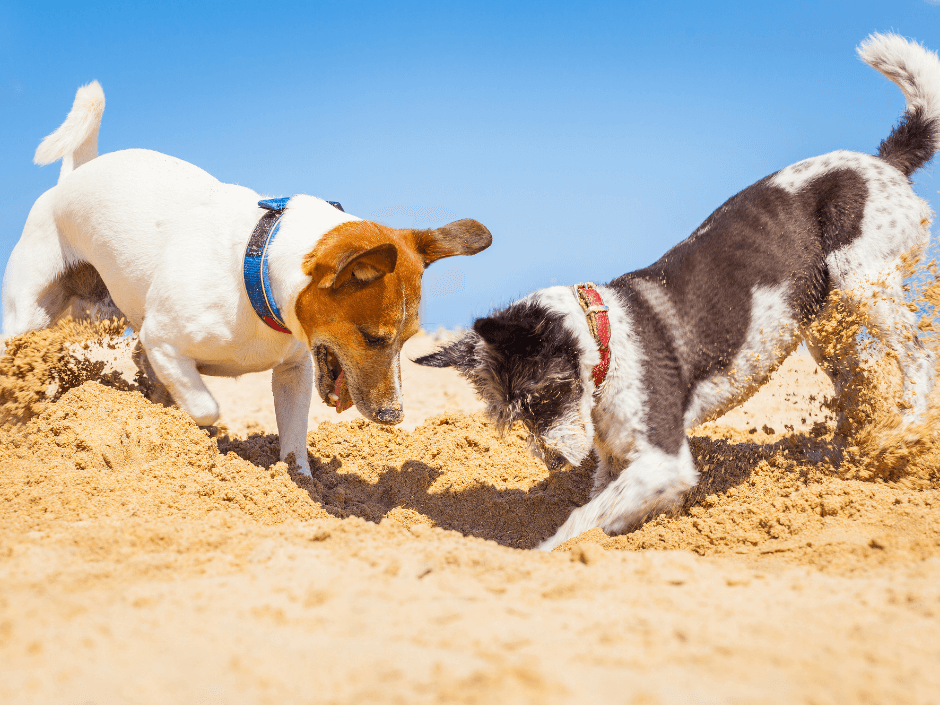Why Your Dog Digs

Behaviour varies from one dog to the next. But digging is one behaviour that can be a nuisance for some dog guardians. We dig the dirt on this sometimes naughty and often puzzling behaviour, with suggestions to help prevent unwanted holes and damage in your home. Let’s take a look at why your dog digs.
When we consider dog behaviour, we look to find causes and explanations. Is it a matter of nature versus nurture? Instinct or learned behaviour? Though a skilled trainer can teach an astute dog to dig, digging is an instinctual behaviour inherited from their ancestor, the wolf.
Wolves dig to uncover small prey residing underground, and to escape the heat or cold. Pregnant wolves dig deep, concealed dens where her puppies remain for up to four weeks. This trait remains in some dogs through selective breeding.
Bred to Dig
Most terriers were bred selectively in England for the work of digging to uncover burrowing prey, such as rabbits, rats and other vermin, and they are ideal dogs for the controversial sport of fox hunting. The name ‘terrier’ comes from the latin word for earth: terra, and exercising this bred instinct is known as ‘going to ground’. Nowadays, terriers are bred for a more friendly disposition; they make terrific family pets.
But digging isn’t exclusive to terriers. Dogs who dig instinctually, creating holes in your lawn and wearing down your carpet, can come from any of the seven dog groups: Toy, Terrier, Gun Dog, Hound, Working, Utility and Non-Sporting.
So, rather than possessing a destructive desire to ruin your garden or furnishings, there are instinctual reasons your dog digs: to hunt after a scent, to escape heat or cold and to create a safe resting place. There are ways you can help prevent keen little excavators from, ahem, digging themselves into a hole. Here are some suggestions to try.
1. Exercise and Mental Stimulation
First and foremost, as with all behavioural issues innate or learned, check that your dog’s exercise and mental stimulation needs are being met. Bored dogs will sniff around to occupy themselves, picking up any hint of underground life to uncover. Enthusiastic diggers will look for scent and dig at carpet and, as is the case with this writer’s cheeky pooch, digging into furniture. While thoroughly amusing, it is destructive.
Try taking them for longer walks than usual. Increase their mental stimulation with training and puzzle toys. Avoid giving them bones, though, which may just encourage them to dig a hole in order to bury them. Dogs instinctually know that bones buried underground will keep for longer.
2. Check Their Nails
A dog may dig to grind down overgrown nails. Keeping them trim may be an easy fix, though the same can’t be said for the guardian of this cheeky pug.
3. How’s the Weather?
Check your dog has all-weather options for resting, particularly if your pup is lying in the holes they have burrowed. In extreme weather, make sure they are comfortable. Dogs’ bodies can’t cool down as quickly as ours do. Provide a cooling bed indoors or in a shady spot and plenty of fresh water in the warmer months. On cold wintery days, give them a warm, snuggly bed in a sunny location, and doggy jumpers and jackets.
4. Let It Be
If you have a dedicated digger and enough room in your garden, try setting apart a designated area, a ‘dig pit’, especially for your dog. Rather than giving in, see it as acceptance of their overwhelming instincts, gifting them with the freedom to exercise their skills. Provide a quarry by burying treats and chew toys within this zone, and watch them do their thing.
This is no new age idea. The ANKC (Australian National Kennel Council) oversees Earthdog trials for terriers and other registered breeds. Rules for entry are strict, but the idea is to allow a dog to use their skills of burrowing for underground quarry. Use this as inspiration for your dog’s dig pit.
Read What a Dog Wants for more information on making your dog happy.
Deterrent
If a dog just won’t let the digging go, using a deterrent is a last resort. Try scattering citrus peel, ground peppercorns or a dog repellant. It is highly unpleasant for their sensitive noses to sniff, and causes them to avoid the area. Frequent reapplication is needed, and it’s a good idea to check there won’t be damage to surrounding vegetation or fabric.
A note on escape artists: escape digging is a different and potentially complex problem. It must be addressed holistically with the help of your veterinarian and a dog behaviourist.
Some dogs inherit more of the wolf’s instinct to dig than others. But there are ways to help your pup find other outlets for their innate needs. And if you can’t beat them, join them through providing a digging outlet – the dig pit. In the end, there is freedom in acceptance. And acceptance is a form of love we can give our precious dogs that give us so much more in return.
